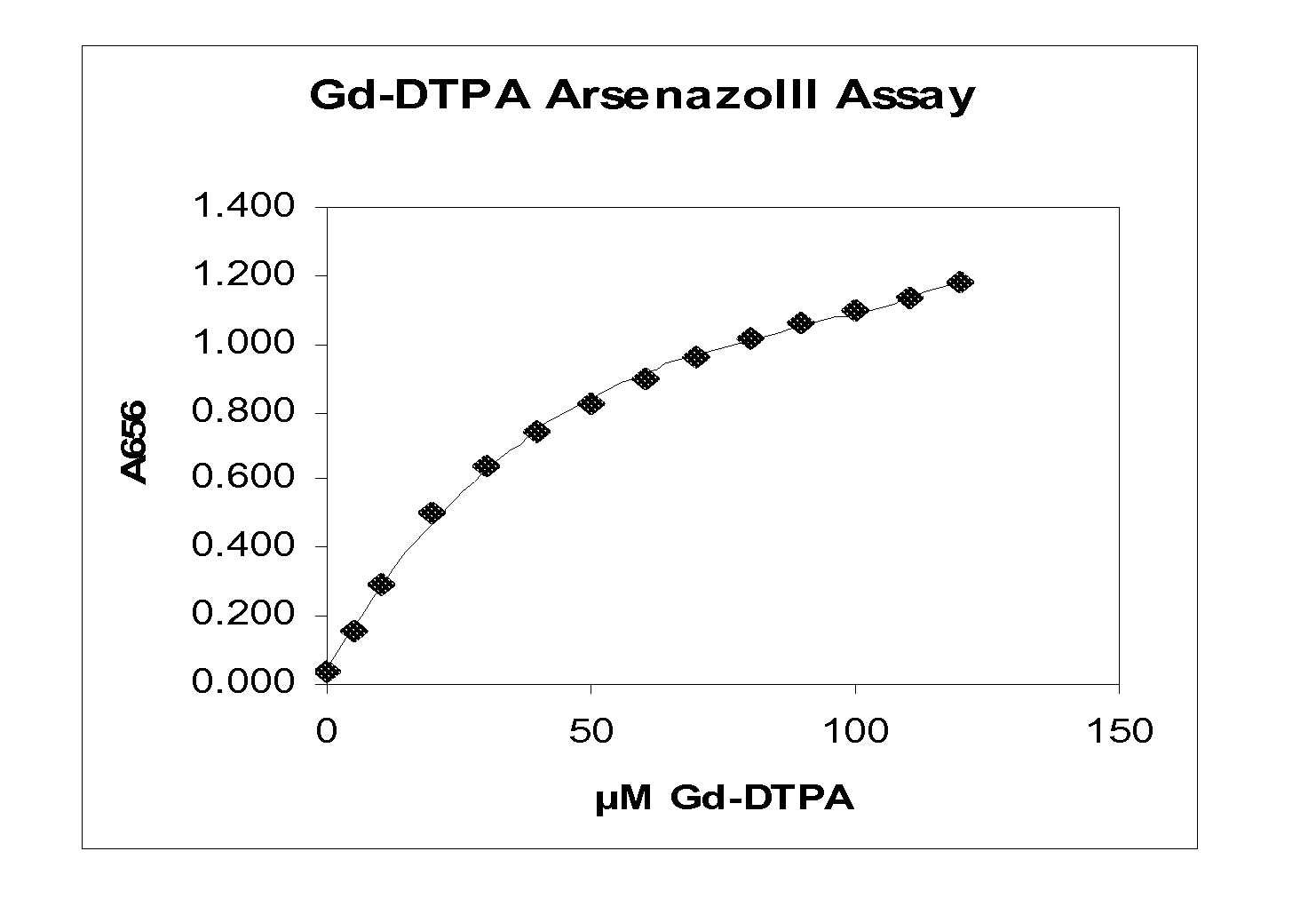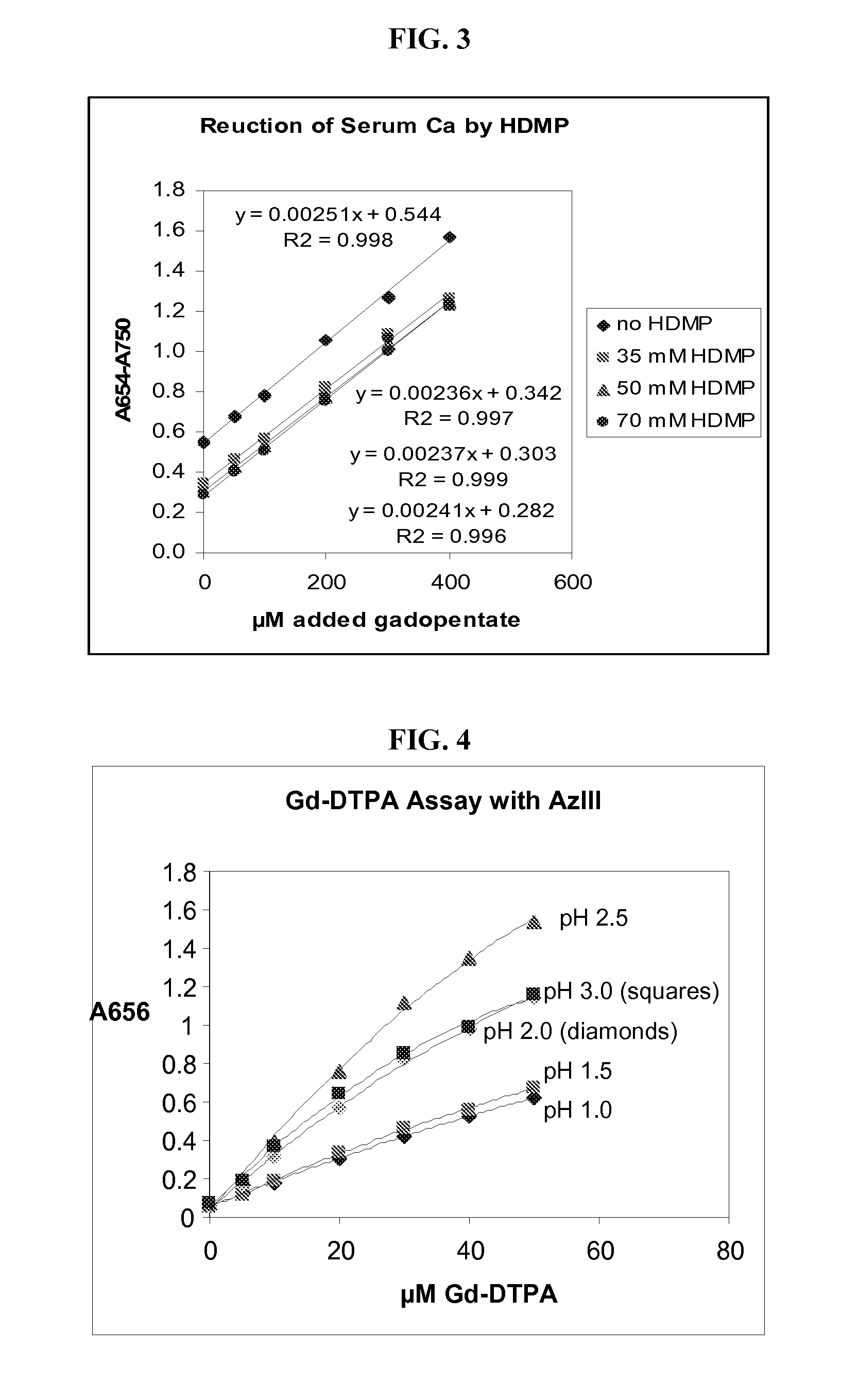Detection of Gadolinium Chelates
a technology of gadolinium chelates and chelates, which is applied in the direction of metal testing, material analysis, instruments, etc., can solve the problems of limited diagnostic specificity of creatinine measurement, inconvenient use, and insufficient utility for diagnosis and management of kidney diseas
- Summary
- Abstract
- Description
- Claims
- Application Information
AI Technical Summary
Benefits of technology
Problems solved by technology
Method used
Image
Examples
example 1
Gadolinium-DTPA Assay in Water
[0065]The release of gadolinium from the gadolinium-DTPA complex was measured using the gadolinium-arsenazo III system. The gadolinium-DTPA, 54.8 mg (0.1 mmol) (Sigma-Aldrich, St. Louis, Mo.) was solubilized in 10 mL of water containing 17 mg of NaHCO3 to produce a 10 mM stock Gd-DTPA. One mL of a reagent solution containing the 100 μM arsenazo III in 20 mM phthalate buffer (Sigma-Aldrich, St. Louis, Mo.), pH 3.0, was mixed with 0.5-12 μL of 10 mM Gd-DTPA stock, producing assay concentrations of Gd ranging from 5-120 μM. FIG. 1 shows a plot of the absorbance of the solution at 656 nm as a function of the gadolinium-DTPA concentration.
example 2
Gadolinium-DTPA Assay in Cat Serum
[0066]The same experiment was performed as described in Example 1 except that the assay was performed using reconstituted lyophilized cat serum (Sigma). 50 μL of cat serum containing 0.1-2 mM Gd-DTPA was added to 1 mL of reagent containing 0.2 mM arsenazo III in 20 mM phthalate buffer, pH 3.0. FIG. 2 shows the absorbance of the solution at 656 nm at various concentrations of gadolinium-DTPA.
example 3
Gadolinium-DTPA Assay in Canine Serum with Removal of Interfering Cations
[0067]An experiment similar to that of Example 2 was performed except that a canine serum sample assay was spiked with 35, 50 and 70 mM HDMP. 0.93 mL of 350 μM arsenazo III in 0.2 M glycine-sulfate buffer, pH 2.35, was prepared containing the various amounts of HDMP. Commercial Gd-DTPA (MAGNEVIST®, Berlex Laboratories, Wayne N.J.) ranging from 50-400 μM was added to 0.07 mL of canine serum. The canine serum was added to the arsenazo III reagent in varying amounts. FIG. 3 shows the net bichromatic absorbance of each solution. This is obtained by subtracting the absorbance of each solution at 750 nm from its absorbance at 654 nm, reducing interference from wavelength-independent absorbance due to sample turbidity.
[0068]To determine the effect of HDMP on removal of ferric ion interference, ferric sulfate in a final concentration of 20 μM was added to 1 mL of reagent containing 250 μM arsenazo III in 0.2 M glycine-...
PUM
 Login to View More
Login to View More Abstract
Description
Claims
Application Information
 Login to View More
Login to View More - R&D
- Intellectual Property
- Life Sciences
- Materials
- Tech Scout
- Unparalleled Data Quality
- Higher Quality Content
- 60% Fewer Hallucinations
Browse by: Latest US Patents, China's latest patents, Technical Efficacy Thesaurus, Application Domain, Technology Topic, Popular Technical Reports.
© 2025 PatSnap. All rights reserved.Legal|Privacy policy|Modern Slavery Act Transparency Statement|Sitemap|About US| Contact US: help@patsnap.com



